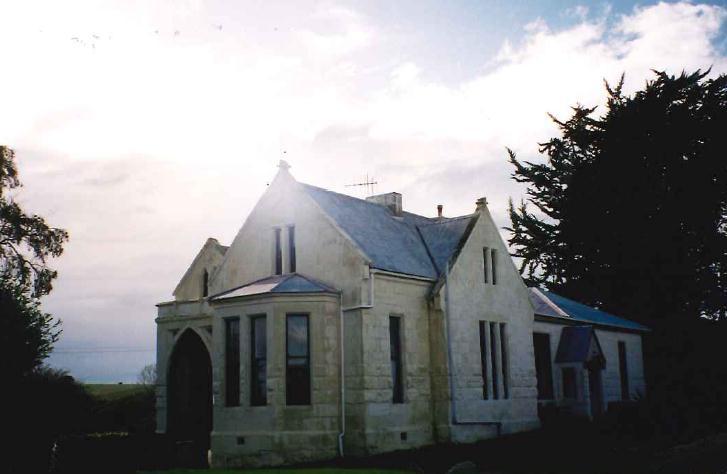Located just to the north of Herbert, the Ōtepopo Presbyterian Manse (Former) was completed in 1867. Designed by noted Dunedin architect, R.A. Lawson, the Ōamaru stone residence is religious Gothic in style and has aesthetic and architectural significance. It is also historically significant as an example of the importance of the church in small rural, nineteenth century New Zealand communities. In 1865 the local Presbyterian congregation commissioned prominent Dunedin architect Robert Arthur Lawson to design a church. Completed in 1866, the church was Lawson’s first use of Ōamaru stone. Lawson was then commissioned to design the manse, his second Ōamaru stone structure. The ten acre site, close to the main north road, was donated to the congregation by Mr Anderson and by October 1866 work was underway. The contractor was Mr King from nearby Ōamaru. By April 1867 the manse was complete. It was described as ‘exceedingly handsome, and is of a rather imposing appearance’. The one and a half storey building had a cruciform plan. The entranceway was adorned with a pointed arch porch and double panelled doors with side and fanlights. The windows on the first floor above the entrance had a trefoil form. A faceted bay window projected from the front elevation. The roof had faceted hips on the north elevation, with a transecting gable on the south elevation. The manse was also notable for its abraded stone work. The lining of the interior walls was ‘laths [sic] and plaster bound with hair from cows’ tails’. A wooden stable was likely erected soon after, as tenders were advertised in May 1867. Reverend John Ryley became the first resident minister of the manse. The Ryleys hosted Sunday School picnics and various meetings, including the Ōamaru Presbytery and church groups such as the Ladies’ Guild. In 1883 the Ōamaru Presbytery granted £300 for an addition to the manse. A tender for timber ‘additions and alterations’ indicated that the plans could be seen as Mr Lemon’s office – presumably, then, the plans were designed by Forrester and Lemon. The plain, single-story, wooden addition was at the rear. The manse saw a number of tragedies. Reverend George Lindsay, who ministered from 1881, lost his 4 year old son, George, at the manse in 1885. In 1896 Reverend A.D. Thomson, from Tasmania, lost his daughters - Grace, aged 5, and May, aged 4, died at the manse within half an hour of each other. By the 1930s there was still no electricity upstairs and the lining was crumbling into holes. The resident children would poke sticks through the holes ‘hoping to find a secret chamber’. The wife of the next minister, John Freeman who arrived in 1937, thought the manse was haunted and lamented the state of the bathroom. Formerly the study, it ‘boasted the luxury of a galvanised tin bath…To save 30cm of piping, the wash basin was half over the bath and made ablutions an awkward performance, while the rest of the room was vast’. In 1938 a new manse was built and the old one was sold to retired farmer Stanley Bratrum, who owned the property until his death. Since then the residence has remained a private home.

Location
List Entry Information
Overview
Detailed List Entry
Status
Listed
List Entry Status
Historic Place Category 2
Access
Private/No Public Access
List Number
5250
Date Entered
4th April 1983
Date of Effect
4th April 1983
City/District Council
Waitaki District
Region
Otago Region
Extent of List Entry
Extent includes part of the land described as Sec 1 SO 441510 and Sec 64 Blk V Otepopo SD (RT 597021), Otago Land District, and the building known as Ōtepopo Presbyterian Manse (Former) thereon.
Legal description
Sec 1 SO 441510 and Sec 64 Blk V Otepopo SD (RT 597021), Otago Land District
Stay up to date with Heritage this month
